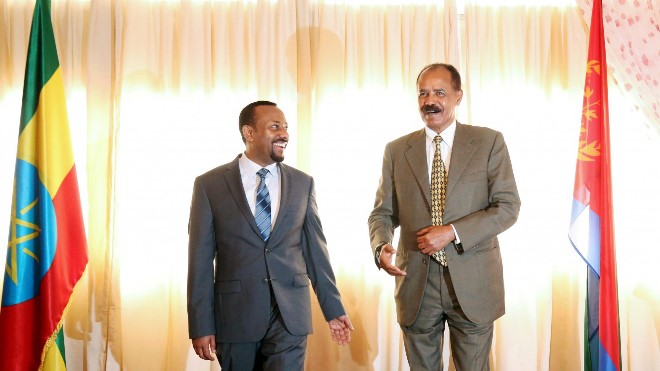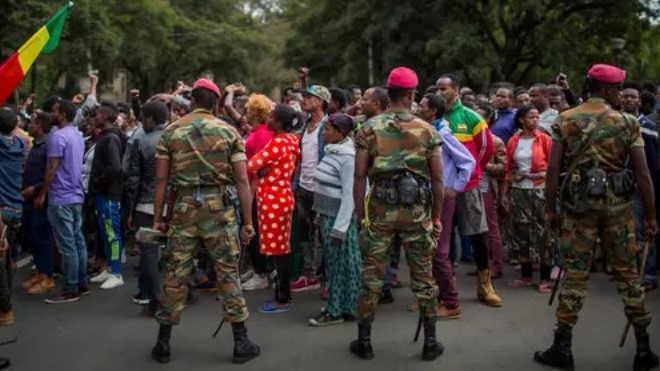Eritrea: Part II - Deciphering the Peace Accord between Eritrea and Ethiopia - An Interview with Yosief Ghebrehiwet

Deciphering the Peace Accord between Eritrea and Ethiopia
Part II
An Interview with Yosief Ghebrehiwet
In Part I of the email based interview with Yosief, he concluded:
- Land demarcation: He argued that “land demarcation” will not take place in the near future due to unresolved issues between Eritrea and the region of Tigray. Eritrea expected that Tigray would be forced to agree or destabilized, which is unlikely to happen.
- Isaias realizes that he cannot allow the country to open up to the free flow of goods, people and ideas without simultaneously committing suicide.
We have asked Yosief three more questions based on his previous analysis.
- How come Tigray (or the TPLF) is not featured in your analysis? I thought the Tigray dimension would occupy a central position in your argument.
- How is the Peace Accord ever going to work if the Tigray reality is bypassed by Isaias (and Abiy)?
- How can Abiy deal with Isaias knowing full well that he is not trustworthy?
A careful reading of the above shows I haven’t omitted the role of Tigray. The fact that both Isaias and Abbiy have conditioned the implementation of the Peace Accord on the further weakening of Tigray says it all. You have equally got it wrong with the other two questions; no one is ignoring or bypassing the reality of Tigray – neither Isaias nor Abiy. The fact that they have a different response in mind doesn’t mean that they are ignoring that reality. So much so, they are hell bent to change that reality before they start implementing the Peace Accord.
Isaias’ focus on the “stability of Ethiopia first” comes from acknowledging the Tigray reality. It couldn’t be the love of Ethiopia that made him say that, but the admission that Ethiopia could do nothing on its side to enforce the Peace Accord at this point in time. Ever since that acknowledgement, the strategy has been for both Isaias and Abiy to bide their time until such an opportune time arrives; with both taking the role of expediting that arrival.
You also asked how Abiy could trust Isaias to fulfill his side of the agreement. Again, this is a wrong question to ask; it has nothing to do whether Isaias is trustworthy or not. This kind of agreement is based on self-interests and the consequences that would follow if not implemented as agreed. For instance, does Abiy have a viable back-up plan if Isaias forsakes his side of agreement? Right now, given that he cannot enforce his side of agreement, he is in no position to demand anything from the other side. That is why he didn’t say much when the Asmara regime decided to close the border.

The Politics of Destabilization
A better way of understanding what is going on in our region in regard to the Peace accord is to look at the politics of destabilization that – deliberately or not – informs most of the actions taken by powerful agents in the region.
Central to Isaias’ regional policy has always been the destabilization of the neighboring countries. Isaias is willing to accommodate Ethiopia now not because the latter is willing to implement the peace accord but that it is trying to do that from a weak position. The fact that this implementation is predicated on the further destabilization of Tigray has great appeal to him, but not to the extent that many of us believe. The total surrender of Tigray to the central power in Addis would be a nightmare to him, for he would lose all the cards he has in facing off Ethiopia. If he finds the balance of power shifting too much towards the center, he might go back to propping up the periphery (including Tigray).
The perpetual destabilization of Ethiopia is central to Sahebia’s survival strategy. Opening up to a prosperous, strong, democratic and stable Ethiopia would be a quick death to that strategy. The Isaias regime can survive without the disputed pieces of land at the border, but it cannot survive the “opening up” that such an implementation would demand. If this totalitarian regime is to survive, Eritrea would have to necessarily remain sealed off from the neighboring countries. Thus, we can say that Isaias has found his equilibrium in the current state: Eritrea remains sealed off; Tigray is cordoned off from the north; and Ethiopia remains destabilized.

The politics of destabilization also remains active on Ethiopia’s side. The center seems to draw its strength by destabilizing the peripheries. Pitting one ethnic group against the other has become a means of consolidating power at the center. And within the parameters of the Peace Accord, destabilizing Tigray has become the main strategy for achieving it.
Many Tigrians also make the mistake of attributing Tigray’s strength to its internal cohesion only. The reality is that it equally draws from the ongoing instability in Ethiopia. If Ethiopia stabilizes in the near future through force or other means, Tigray will find itself cornered. The undermining of Tigray will not take place through armed means but through economic boycott or even economic sanction from within (the center) and without (Eritrea).
In fact, one of the main reasons for the latest move of Isaias to close the border is the realization that the encirclement of Tigray could only be achieved through economic means. Whether Abiy subscribes to “sanctioning Tigray” from within is to be seen in the near future; right at this point, with all the destabilization going on inside the country, he cannot afford to say it loud and clear.
So, what is to be done?
Ideally, the politics of destabilization has to come to an end. That is why Eritrea’s fate depends so much on what is going on inside Ethiopia. A stabilized Ethiopia, an Ethiopia that has made peace with its peripheries (especially with Tigray), would be the end of Isaias regime. A unified, stabilized and democratic Ethiopia is the ultimate nightmare of Isaias. What Abiy doesn’t get is the totalitarian nature of Shaebia. As in all cases of totalitarian states, it cannot survive by opening itself to the rest of the world. That is what happened when Eritrea briefly opened its borders; that is what will happen if forced again to open up.
Short of this ideal solution though, we will have to wait and see what moves are being made inside Ethiopia by relevant actors, the most important of which would be that played by Tigray. It cannot be lost on Tigrians that the encirclement of Tigray will eventually take in its economic form. How will they react to this will also affect the fate of the Isaias regime.

In the short term, my fear is that Abiy will accommodate Isaias’ totalitarian impulses. Isaias’ primary concern is that there should be not the slightest of infringement over the total control he has over the Eritrean people; everything else – including border demarcation – is secondary. With the opening up of the border, it was both the political and economic control that Shaebia had for more than three decades that suddenly came under threat. No wonder this was taken by Shaebia as an existential threat. What Isaias wants now is, first, a closed border all along Tigray, which will serve as a double-edged sword: on the one hand, it keeps the main part of Eritrea sealed off from the rest of Ethiopia and, on the other hand, it will cordon off Tigray. Second, he wants to make Assab the only contact point with Ethiopia, one that will give Shaebia total control over the outflow of its people and total monopoly over the economic transaction. And Abiy seems ready to accommodate him on these demands.
If so, there is some truth in the charge that many Eritreans (and some Ethiopians) are making: that Abiy is making peace with Isaias and not with the Eritrean people.
… to be continued


![[AIM] Asmarino Independent Media](/images/logo/ailogo.png)